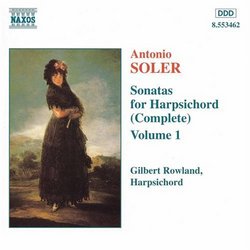| All Artists: Antonio Soler, Gilbert Rowland Title: Antonio Soler: Sonatas for Harpsichord (Complete), Vol. 1 Members Wishing: 1 Total Copies: 0 Label: Naxos Original Release Date: 1/1/1996 Re-Release Date: 6/18/1996 Genre: Classical Styles: Forms & Genres, Sonatas, Historical Periods, Classical (c.1770-1830) Number of Discs: 1 SwapaCD Credits: 1 UPC: 730099446228 |
Search - Antonio Soler, Gilbert Rowland :: Antonio Soler: Sonatas for Harpsichord (Complete), Vol. 1
 | Antonio Soler, Gilbert Rowland Antonio Soler: Sonatas for Harpsichord (Complete), Vol. 1 Genre: Classical
|
Larger Image |
CD Details |
CD ReviewsDoes Soler Out-Scarlatti Scarlatti? John Austin | Kangaroo Ground, Australia | 08/01/2001 (4 out of 5 stars) "Listeners attracted to this review might have been excited by seeing this composer's name attached to a piece called "Fandango" which provides a show piece for virtuoso harpsichord players. It is not certain that Antonio Soler (1729-1783) wrote it, but what is certain is that his output included about 150 keyboard sonatas. British harpsichordist Gilbert Rowland has had long experience in studying, recording and performing them. His complete survey for Naxos, begun in 1995, has reached Volume 7 so far and is more than half way complete. Soler was a Spaniard and is reputed to have studied with Domenico Scarlatti. It is possible he was one of the copyists of manuscript volumes of the older composer's sonatas. There's no doubt that forms and formulas developed by Scarlatti are evident in Soler's sonatas: they are almost all in binary form (made up of two halves, each repeated), they require frequent hand crossing, and they are often characterised by relentless drive and zest. Both composers were audacious and adventurous in their music but not always in similar ways. Perhaps Soler's sonatas exploit the percussive capabilities of the harpsichord more than Scarlatti's. Certainly Soler's sonatas have not been so readily taken up by modern pianists, who may find greater opportunities for expressive, cantilena playing in the older composer's works. Gilbert Rowland uses a reproduction two manual harpsichord and is recorded in a spacious acoustic. Volume 1 provides a cross section of what can be heard in all the volumes released so far, including one of Soler's extended four movement sonatas." Antonio Soler on Naxos Robin Friedman | Washington, D.C. United States | 04/26/2006 (5 out of 5 stars) "It is indeed a great opportunity to hear the sonatas of Scarlatti and of Padre Antonio Soler (1729 -- 1783), who probably studied with Scarlatti, on two ongoing and extensive series of recordings on Naxos. The Scarlatti series features performances on the piano by a variety of artists while the Soler series is performed on the harpsichord by a single artist, Gilbert Rowland. Soler's 150 sonatas will require 15 or 16 CDs to record of which 11 are available as of this writing. The CD I am discussing is the first in the series.
Like Scarlatti's sonatas, Soler's sonatas are largely in binary form with each part repeated. Both Scarlatti and Soler are transitional figures between baroque and the "galant" early classical style. But Soler's later work actually reaches the gallant style and his later four-movement sonatas, one of which is recorded on this disk, owe a great deal to the Italian overture and to Haydn's early symphonies (for example the "Philosopher") in their slow-fast-slow fast structure. Soler's works feature, as do Scarlatti's, passages of dazzling virtuosity, hand-crossings, glittering runs and scales, repeated notes, trills and ornamentation, guitar-like strumming, Spanish dances, echoing passages for the hands, and strong rhythms. I find Soler's sonatas tend to be more percussive than those of his predecessor, but Soler was entirely capable of writing slow, reflective pieces as well. As Rowland's fine notes to this CD indicate, Soler wrote frequently in unusual harmonies and modes. For example, he employed the Phrygian mode in several works on this CD. (The Phrygian mode is an ancient Greek scale. You can hear it by playing the white keys on the piano between d and d'). This CD includes ten binary sonatas. They are not arranged chronologically, but some are paired in ways suggested by modern scholarship. Thus, two nearly-contemporaneous sonatas in F sharp minor and major, two in D minor, and two in C minor are grouped together on this disk. I enjoyed the slow and lyrical sonata no 110 in D flat and the lively sonata no 101 in F, a dance with an appealing drone accompaniment. The four-movement sonata in C features an endearing slow opening, two quick joyful movemements, the second and fourth, and two minuets in the third movement. This is a delightful CD which will introduce the listener to the work of Padre Antonio Soler and encourage further exploration of his works and those of his great teacher. " |

 Track Listings (14) - Disc #1
Track Listings (14) - Disc #1